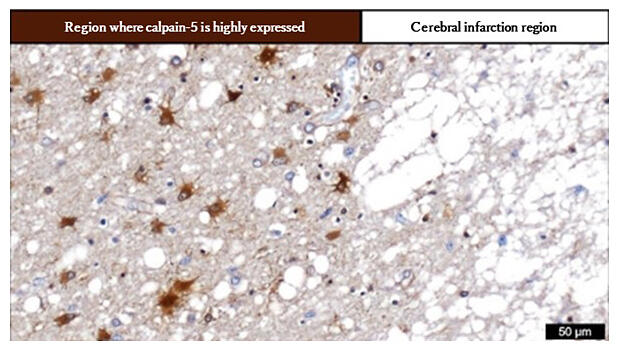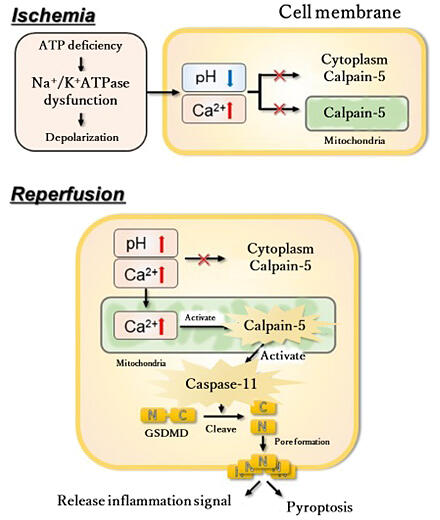A research group led by Associate Professor Taku Ozaki of the Graduate School of Science and Engineering at Iwate University, in collaboration with Hirosaki University, announced their discovery that "calpain-5," an enzyme localized in mitochondria, activates the molecules that promote the inflammatory response to cause ischemia and reperfusion injury in the brain. In mouse brain cells, mitochondrial calpain-5 was confirmed to be more proactively involved in inflammatory responses than cytoplasmic calpain-5. The level of calpain-5 expression was also increased in the cells surrounding the human cerebral infarction site. The findings are expected to lead to the development of drugs that suppress reperfusion injury. The study results were published in the November 9 issue of the international academic journal Biochimica et Biophysica Acta - General Subjects.

Provided by Iwate University
In cases of cerebral infarction or myocardial infarction, blood flow decreases under ischemia (the condition of restricted/reduced blood flow). To prevent cell death caused by this event, treatment with surgery or thrombolytic drugs (if there is arteriosclerosis or blood clots) is administered to quickly restore blood flow to a normal state. However, as blood flow is restored, it can cause reperfusion injury, whereby the inflammatory response and resulting damage are more extensive than those during ischemia. In ischemia−reperfusion injury, the cells that had not been affected by ischemia are instead damaged by reperfusion, with nerve cells being particularly susceptible, and the disease condition worsens. However, the detailed mechanism behind this phenomenon remained unclear.
Calpain is a calcium-dependent cysteine-neutral protease of which 15 types have been identified in humans. Although the function of calpain-5 in the cell was unknown before this study, the research group had confirmed that, compared with cytoplasmic calpain-5, calpain-5 localized in the mitochondria is more sensitive to calcium signals. The research group had further confirmed that mitochondrial calpain-5 activates caspase-4, which promotes inflammatory responses during endoplasmic reticulum stress. However, it was unclear if calpain-5 is also involved in inflammatory responses in the body.
The research group then isolated the respective cytoplasmic and mitochondrial calpain-5 molecules from mouse brain tissue and compared their calcium responses. They observed that mitochondrial calpain-5 had a faster response and acted more proactively.
Furthermore, in the brain tissue of a mouse model of cerebral infarction, mitochondrial calpain-5 was found to be activated early after reperfusion. Immunohistochemical staining revealed that mitochondrial calpain-5 is mainly expressed in nerve cells.
To investigate the function of calpain-5 in nerve cells, the research group suppressed the function of the calpain in a mouse hippocampal-derived nerve cell line. The suppression inhibited activation of the enzyme caspase-11, which is involved in inducing inflammatory signals and cell death. Caspase-11 activation is known to induce inflammation through cleavage of the protein gasdermin D (GSDMD) in cells.
In human patients with cerebral infarction, calpain-5 was found to be specifically overexpressed in the areas where nerve cells had been lost around the infarction site, and calpain-5 was later found to be overexpressed in astrocytes (a type of glial cell) as well.
Mitochondrial calpain-5 acts at the early stages of ischemia−reperfusion injury in nerve cells in the brain and appears to be upregulated in reactive astrocytes in damaged tissue at the terminal stages.

Provided by Iwate University
Ozaki commented, "Currently, we are searching for compounds that can specifically inhibit calpain-5. We hope that they will become drugs that can suppress ischemia and reperfusion injury when used in combination with thrombolytic agents after cerebral infarction. Mitochondria originated from bacteria and are assumed to have been incorporated into humans during the evolutionary process of bacteria−human coexistence. What are the benefits of their symbiosis with mammals? We would like to clarify what humans are to mitochondria."
Journal Information
Publication: Biochimica et Biophysica Acta - General Subjects
Title: Role of calpain-5 in cerebral ischemia and reperfusion injury
DOI: 10.1016/j.bbagen.2023.130506
This article has been translated by JST with permission from The Science News Ltd. (https://sci-news.co.jp/). Unauthorized reproduction of the article and photographs is prohibited.




